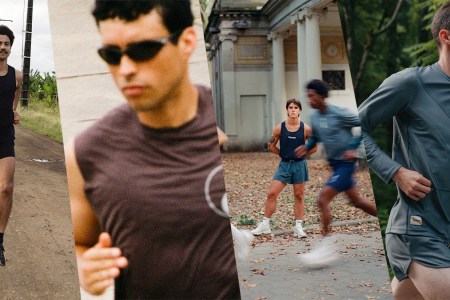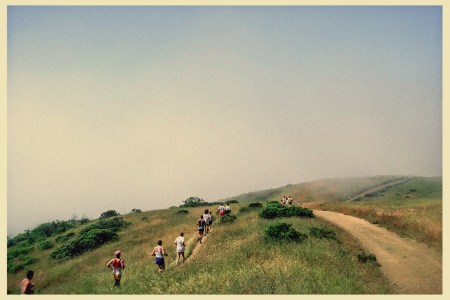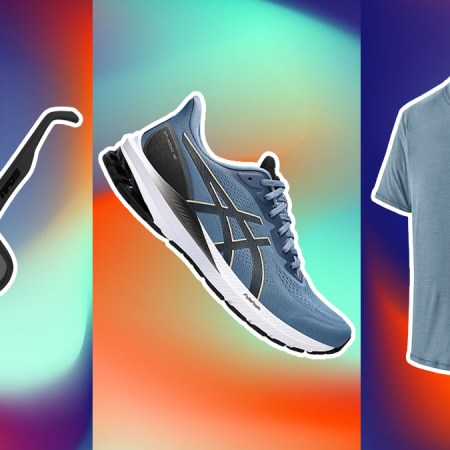I’ve had an odd running life, which means I’ve had a normal one.
The sport’s brought me equal parts pain and wonder. I’ve used it as a refuge, as a coping mechanism and as a launching pad for adventures — in Montauk, in Death Valley, in the Scottish Highlands, you name it.
At one point in my life, I hated running so much I swore I would never take it up again. Today, I can’t imagine my life without it. On days where I do run, the last few minutes of the final mile are my favorite of the entire day.
Coming to grips with running — and learning to welcome it in its healthiest form — took me a long time. I’m lucky to have the relationship to the sport that I do now, but I’ve made so many mistakes along the way. Often, when I’m asked how to get into running, I’m so excited they’ve approached me on the topic that I’ll start planning their first month of workouts. By the end of my monologue, I can see that I’ve ruined it. Fat chance they’re still interested after they’ve heard me extolling the joys of “fartleks.” If they somehow are, they’ll be abandoning the program by Week Two, regardless.
The following is the pitch I’ve been too breathless to effectively communicate: a measured, well-paced prescription for those looking to get into the sport. (Or, alternatively, for those who have gotten into it — perhaps during the “running boom” of the early pandemic — but found their interest peter out or their exhaustion total up.)
It’s possible to stitch together a running life in stops, starts and sputters, but a sustainable one is best built by embracing these core credos. From the importance of recovery fitness to my skepticism for run streaks, here’s what you need to know about becoming a runner — no matter how many miles you’ve run, or birthdays you’ve celebrated.
How to Prevent the Most Common Running Injuries
There are six of them. We explain how to train against each.Pace Yourself
A few years back, the bourbon label Knob Creek wanted to design a program meant to encourage the health of bartenders around the country. They were hit hard mentally and physically during the pandemic, and even in normal times, struggle to stay in shape due to the nature of their work.)
The higher-ups envisioned a virtual running club. But the idea wasn’t testing well, so the creative agency behind the initiative decided to brand it as a jogging club instead, dividing participants into regional teams with fun names (“Hair of the Jog”) and low-stakes goals. It was a smash; after 12 weeks, 75% of them met a distance goal, many had lost weight and at least one had called the experience “life changing.”
Point being? Start slow — the goal here is to turn running into a routine, not a chore. You’re allowed to jog before you run, and in the end, the difference doesn’t really matter. Thankfully, the run-club revolution has ensured that nascent runners can find similar pace groups with ease (some run clubs are expressly dedicated to running slow — like Slow AF Run Club.) And if a run club isn’t your thing, remember that “run-walks” count. Even running obsessives like Jesse Itzler, who runs ultras and founded the Runningman Festival, swears by the strategy. His cadence: seven minutes running, three minutes walking, repeat.
I recommend running at whatever your “conversation pace” is in the early days, and focusing on running a bit farther before you attempt running any faster. A one-mile loop is a great place to start. Importantly, running should not replace all other forms of exercise overnight. Limit your running to a four-a-week max, at first, to keep both the activity and your knees fresh. Experiment with different paths so it feels like an exploration, not a forced march. And consider bringing earbuds, so you can listen to something other than your panting. There’s a decent chance that the last time you ran with any regularity, you didn’t have access to a good pair. Take it from someone who loves running — without music, the whole affair can really suck.
No Rush on Racing
For some who take to running, it’s tempting to map every adventure on Strava, compare yourself to others in your age group or show up to wildly popular running locales with an aim to impress (e.g. New York’s West Side Highway on a Friday). Broadly speaking, that’s all fine — as obsessions go, you could do worse than one of the most heart-healthy activities known to man. But the competitive/performative maw of running culture can lead many nascent runners to believe that the point of the sport is to enter races and post sweaty finish line photos on Instagram. And that’s far from the truth. You can be a lifelong runner and never enter a single race, be it a local 5K or a major marathon.
In fact, it might be in your best interest to refrain from entering a race for at least your first year of running. Why? Race-training can carry some of the uncomfortable qualities of goal-oriented fitness. You lock in for a few months in the hopes of completing a single race, you do it, and then, within 72 hours, you start to appreciate “having your life back.” Perhaps you begin sleeping in again, or eating a little more at certain points in the day. Four months go by and you’ve barely run at all, so you think about signing up for another race, as a motivation tool to get back into shape again.
To dodge the plight of the on-again, off-again racer, and lean into the lifestyle of a runner, try to eschew the publicly competitive aspects of the sport for a bit. That doesn’t mean you can’t be ambitious; just begin with goals that you only share with yourself. When you’re ready to take that next leap in running, you’ll know. FYI: in the last 12 months, I’ve only competed in two races!
The Best Running Brands Are Mile-Tested and Editor-Approved
Runners have more gear options than ever, and these labels are leading the chargeSpend Money
You don’t have to go crazy. But that line about runners “only needing” a pair of laced-up sneakers and open road is trite and hollow, especially in a golden age of performance tech. You should absolutely spend a few bucks on a pair of everyday trainers that won’t cause you shin splints (get a gait assessment at your local run shop!), some socks that won’t cause you blisters and some running shorts that won’t chafe your most sensitive regions. Plus: whatever other layers, hats, phone cases or water bottles you need to feel confident and happy about your new hobby.
I get asked once a month about my “favorite running sneakers.” I sort of lie. My ultimate favorite is a carbon-plated pair that burns rubber. Who knew track workouts could be so fun? But for a reasonable, everyday shoe, I like On’s Cloudsurfer. Before buying shoes online, though, make sure you have a good sense for your foot width, your heel width, the severity of your arches, your intended mileage and your propensity for certain aches and pains (as you may need orthotics, too). My girlfriend recently visited Fleet Feet for a full test of these criteria — which included 3D imaging of her feet. When it was all said and done, she went home with a pair of New Balance 1080s and CURREX insoles, and ran a pain-free four miles the next day. It’s worth making the appointment!
My favorite running outfitters, meanwhile, include: Janji, Tracksmith, Allbirds (great shirts, believe it or not), Ten Thousand, Iffley Road, Balega (socks!) and Vuori. It’s expensive stuff throughout, be warned. But your body’s nooks and crannies will thank you in the long run.
Skip the Streaks
Heads up: there’s a subset community of runners known as “streakers.” The most famous and gung-ho of the lot have entries in the United States Running Streak Association or Streak Runners International, and have run at least one mile within each calendar day for years on end, come rain, sleet or broken collarbone. Of the near-4,000 runners on these lists, their only hope of climbing the ladder is in waiting for those above them to finally stop running…or die.
While coverage on run streaks is invariably positive, emphasizing how inspirational and resilient streakers are, it’s important to note that the practice has birthed a dubious “no days off” ethos from brands and influencers in the world of running.
Take it from Colleen Quigley, a middle-distance runner who competed at the 2016 Olympics, won gold at the 2019 USATF Indoor Championships (finishing the mile in 4:29) and now runs with Lululemon. “The tricky thing with a run streak is that running is an awesome activity that is great for the body and mind…except for that pesky overuse issue,” Quigley told InsideHook. “It’s a repetitive motion, it’s weight-bearing and it’s fairly high-impact, so it requires proper recovery between runs to let your muscles and tissues repair.”
As you get into running, try to remember that you don’t have to — and and honestly, should not — run every single day. Your body deserves its rest. Listen to it when it’s presenting as overtaxed, let alone hurt, and learn to appreciate that you can become a better runner on a given day without actually running.
How You Should Actually Warm Up Before Your Runs
If you haven’t yet, it’s time to ditch static stretchingRecovery Is King
How so? Through old-school self-care, which now often involves newfangled machinery, like massage guns or automated compression sleeves. If you’re not looking to shell out for the toys, just commit to habits that are kind and attentive to your body’s tissue and joints, which, admittedly, are bound for a pounding after even just a few days of running on cement or trails a week. Some essential rules, along with some offbeat tips:
- Prioritize dynamic stretches before each run (leg swings, skips, backpedals, etc.) and static ones after a run, when the body is warm and receptive to flexibility-building poses (seated back twists, calf stretches, forward folds, etc.)
- Take at least two days off from running a week, and make sure one run a week is a “recovery run” — slow, steady, a chance to pinpoint aches in the body. “Zone 2” runs are critical for any routine!
- Fuel up properly: running burns twice as many calories per minute than walking. I’ll keep it to a banana, water and maybe some oatmeal an hour before I get out there (lots of runners swear by coffee, too), but once the run is done for the day, I’m eating fruits, veggies, nuts, grains and fish all day to avoid the “relative energy deficiency” trap.
- Cross-train with cycling, yoga, boxing, swimming, soccer…you name it. Running doesn’t have to become the be-all, end-all of your physical activity. In fact, it’s fun to see how your newfound endurance translates to other concentrations.
- Sleep with intention — to the tune of at least seven hours a night — and cancel morning runs if you’re exhausted or under the weather. It isn’t worth it. You’ll get ’em tomorrow.
- Keep an open mind to emerging “hacks” that’ll make you a guinea pig in your training program, and make the whole operation of running a lot more fun. I recommend looking into beet juice as a nitrate-boosting pre-workout, cold water therapy for the restorative benefits and running backwards to give your lower half a unique challenge.
Need for Speed
There will come a time where you’ll feel ready and motivated to graduate to a more serious running regimen. That may involve signing up for a race, joining a running club, or choosing a time you’d like to get under. At any rate, you’ll eventually come face to face with track workouts.
For new runners, they can seem incredibly intimidating; after all, even serious runners speak about them with a mixture of reverence and revulsion. I wish I could dispel that reputation, but it’s true…they suck. They’ll also make you a better, faster runner. What should you know about them right now? Not much — explaining track workouts to a nascent runner is sort of like expecting a pre-schooler to have a grasp of long division.
Suffice to say, they involve running repeats around a track. A basic example would involve doing the same distance over and over again with short periods of “active rest” (the lightest jog you’ve ever seen) in between each interval. So, a 12 x 400 workout would ask for 12 laps around the track, all at 90% effort or more, with maybe two minutes of rest in between each. Other, more complicated workouts play with varying distances or ask for different pacing goals. The one thing to know, as scary as track workouts sound, is that all ages are capable of performing them. There is no age limit. Speed is relative, but effort isn’t, and as long as you want to become a better runner, the track is always there to help that process along. I would recommend making your first foray onto the track at a time that the weather’s good, and you’ve been putting in time on the roads for at least three months.
The Globetrotting Guidebook: Our Most Memorable Runs Across the Planet
A powerhouse panel of pro runners, legendary coaches and race directors share the routes they’ll never forgetGlobetrotting
A friend of mine once told me that he packs his running shoes anytime he’s visiting a new city. He likes to run an aimless three miles just after he’s checked into his hotel. It’s his version of riding the local double-decker bus.
I’ve gotten into the habit of running on my trips, too (whether I’m there for work or leisure), and now I wouldn’t have it any other way. This is perhaps the greatest gift a regular running routine can offer you — when you’re on the other side of the world, eager to make some sense of a place with your feet, you can do so without needing to wheeze on the side of the road for 45 minutes. You don’t even need to fly somewhere to take advantage of this superpower. There are parks and neighborhoods in all of our backyards, primed and ready for some exploration. More than hitting a specific time, or taking home a medal, this is the running future you should dream about and cherish. One where you’re free to roam…and fit enough to find your way home.
Whether you’re looking to get into shape, or just get out of a funk, The Charge has got you covered. Sign up for our new wellness newsletter today.





























